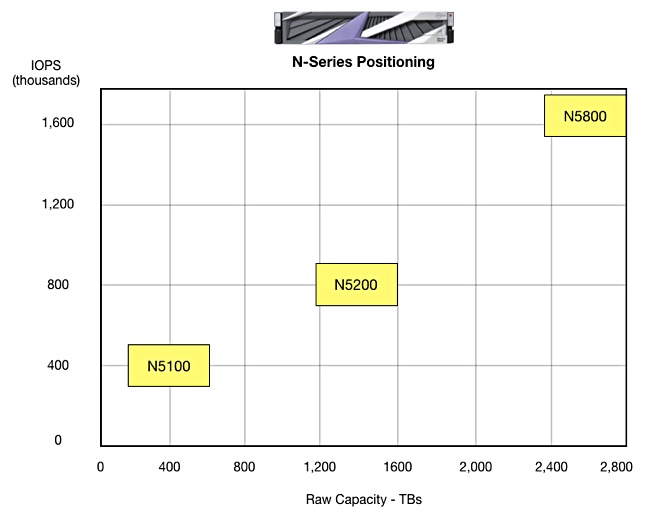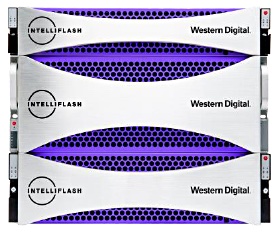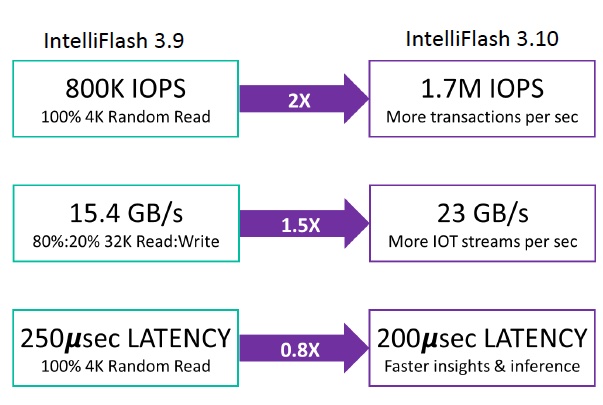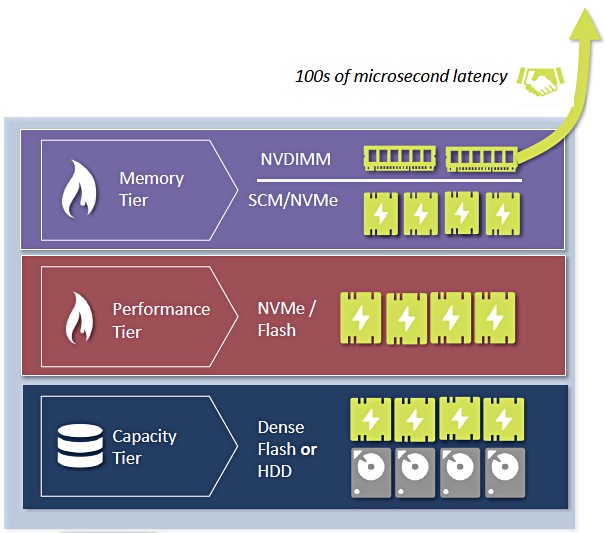Western Digital has updated the IntelliFlash storage array range with a lower-priced entry-level NVMe models and a higher-capacity SAS array. The storage giant has also added live dataset migration and an S3 connector to the IntelliFlash OS.
IntelliFlash has three product lines:
- T-Series SAS hybrid flash/disk arrays with 1ms – 2ms latency
- HD-Series high-capacity hybrid NVMe/SAS all-flash arrays with <1ms latency
- N-Series NVMe drive arrays with 200𝞵sec latency
All three have a dual active:active controller design and run the IntelliFlash operating environment.
WD is adding N5100 and HD2160 arrays to the N-Series and HD-Series products.
N5100
The N5100 is characterised as an affordable all-flash array for the masses and slots in below the existing N5200 and N5800 with nicely straightforward ordering:
- N5100 – 400 K IOPS, 400 TB maximum raw capacity
- N5200 – 800 K IOPS, 1.4 PB maximum raw capacity
- N5800 – 1.7 M IOPS, 2.5 PB maximum raw capacity
The N5100 uses Western Digital SN200 dual-port NVMe SSDs with capacities of 3.84 TB and 7.68 TB. It has a PCIe mid-plane to support the dual-port NVMe SSDs.

All three come in 2U cabinets and have 200 𝞵sec latency. They also have NVDIMMs in their controller units.
The N-Series supports block (FC, iSCSI) and file (NFS, CIFS, SMBv3) protocols and features inline deduplication and compression, cloud monitoring and prediction, snapshots, replication, and encryption.
They have SAS-connected expansion shelves, either 6 x 2U SAS flash or 6 x 3U hybrid flash/disk. These can be added non-disruptively and mixed and matched in the same system.
The expansion cabs have controllers but cannot function as stand-alone systems.
This provides a 2-tier design with an NVMe drive performance tier and either SAS flash or SAS disk/flash capacity tiers. The IntelliFlash operating environment (OE) has data placement capabilities to take advantage of this.
Latency from the SAS expansion tiers will be longer than from the NVMe drives.
HD2160
WD has added a high-end box to the HD-series (HD stands for ‘High Density’) and more than doubled the previous maximum capacity. There are now three HD systems:
- HD2040 – 92TB raw with 3.8TB SSDs, capacity expandable to 644TB
- HD2080 – 184TB raw 7.6TB drives, expandable to 1.288PBs
- HD2160 – 368TB raw expandable to 2.576PB
The HD2040 and 2080 scale to maximum capacity with SAS expansion cabinets. The base cabinet has a SAS mid-plane and 24 x SAS drive slots.

The HD systems have less than 1msec latency, helped by having NVDIMMs in their controller cabinets..
The HD2160 base cabinet has 24 drive bays and uses Ultrastar DC SS530 15.3TB SAS SSDs in this and the expansion cabinets. It has a maximum of 10PB of effective capacity in 14U after data reduction.
IntelliFlash OE
IntelliFlash OE is upgraded from 3.9 to 3.10 and accelerates IOPS and bandwidth through improvements to its data path procedures. Here is a chart of what it does with the N5800:

WDC claims the 5800 delivers the best-in-class random performance for fully-featured mid-range all-flash arrays.
V3.10 runs all three IntelliFlash product series; T, N and HD and they can be mixed and matched in a “unified framework”. IntelliFlash OE automatically separates metadata from application data and it organises, aggregates, and places metadata on low-latency media, to help accelerate deduplication, compression, snapshots, clones, and thin provisioning.
It has data placement capabilities for the hybrid flash and hybrid flash-disk arrays, to place data on the fast, medium or slow tiers. Caching algorithms use access frequency and other data characteristics to place data in the right tier.
The intention is to deliver more predictable low latency for data reads and writes.

Western Digital was unable to tell us at time of publication what NVDIMMs or storage-class memory devices are supported
IntelliFlash OE v3.10 has live dataset migration of Fibre Channel and iSCSI LUNs between IntelliFlash arrays across an Ethernet LAN with no disruption to service. This supports, for example, upgrades from T- and HD-Series to the N-series. This feature was initially offered in v3.7 of the IntelliFlash OE.
Erik Ottem, WD’s senior director for product marketing, said files are included in this live data set migration.
An Amazon S3 connector is added in v3.10 so that IntelliFlash volume snapshots can be sent to an ActiveScale object storage system or any other S3-compliant target system on-premises or in the cloud. This capability can be used for disaster recovery, test and development or other use cases.
V3.10 also adds:
- SMB3 optimisation for Windows File Server 2016 deployment on Hyper-V
- Simplified VMware deployments and management of vSphere datastores
- Powershell Toolkit for automating Windows storage








